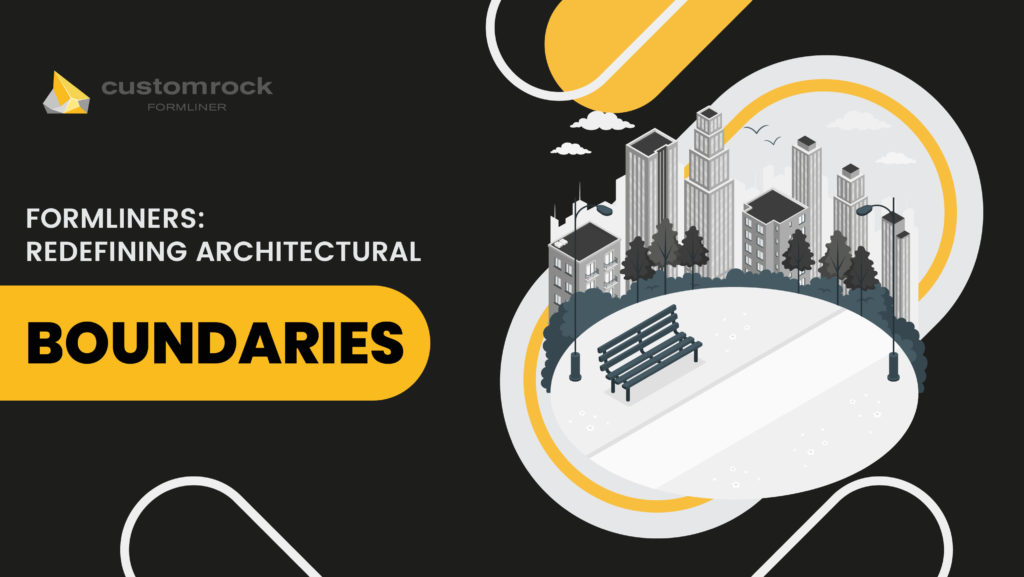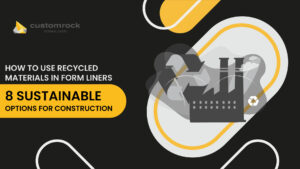TL: DR
Formliners have redefined architectural boundaries by enhancing the aesthetics and functionality of concrete surfaces. These innovative tools add depth, texture, and amazing designs that allow architects to create visually stunning structures. Their versatility, cost-effectiveness, and sustainability make them a popular option in modern construction.
However, working with formliners has challenges. Proper material selection, design precision, and formwork stability are crucial for a successful project. Weather conditions can also impact the installation process. Despite the challenges, formliners remain preferred for achieving great architectural results.
Compared to the traditional techniques, formliners offer better efficiency, aesthetics and more variety of designs and patterns. Formliners are also comparatively eco-friendly since they are reusable and made of recyclable materials.
How Formliners Redefine Architectural Boundaries?
Formliners are innovative architectural tools that revolutionize the way buildings and structures are designed and constructed. They play an important role in enhancing the aesthetics and functionality of concrete surfaces. Here’s how formliners achieve this feat:
-
-
Enhancing Aesthetics:
-

Formliners add depth to concrete surfaces which enables architects to incorporate designs, patterns, and textures on the concrete surface. This artistic touch enhances the overall aesthetics of the building and makes it stand out from ordinary concrete structures.
-
-
Versatility:
-
Formliners offer a wide range of design possibilities, from natural textures like stone, brick, wood, and rock to abstract patterns and custom designs. This versatility allows architects to tailor the appearance of the concrete to match the specific theme or style of the project.
-
-
Cost-effective:
-
Utilizing formliners is a cost-effective way to achieve impressive architectural results without resorting to expensive building materials or labor-intensive handcrafted finishes. The liners are relatively affordable and can be used multiple times which makes them a budget-friendly solution for architects.
-
-
Ease of Installation:
-
Installing formliners is a straightforward process. They are placed directly onto the formwork before pouring concrete. The ease of installation saves time and reduces the complexity of the project.
-
-
Replication of Natural Materials:
-
Formliners can also replicate the appearance of various natural materials, such as wood grain, stone, or even masonry work. This means that architects can achieve the desired look without the need for costly and scarce natural materials.
-
-
Sustainability:
-
By utilizing formliners to mimic natural materials, architects can help conserve natural resources. This sustainable approach reduces the demand for harvesting and extracting materials from the environment.
-
-
Customization:
-
Formliners can be custom-made to suit the unique vision of architects and designers. This level of customization ensures that the finished concrete surface perfectly matches the project’s intended design, making it an ideal choice for bespoke and artistic projects.
-
-
Durability:
-
Concrete structures with formliners maintain their appearance and integrity for an extended period. The liners protect the concrete from weathering, abrasion, and UV radiation which ensures the longevity of the architectural structures.
-
-
Branding and Identity:
-
For commercial projects, formliners offer an opportunity to incorporate branding and identity into the design. Company logos, patterns, or specific textures can be imprinted on concrete surfaces. This helps reinforce the project’s identity and make it instantly recognizable.
-
-
Iconic Landmarks:
-
Formliners are used to create iconic landmarks worldwide. From innovative facades on modern buildings to historical restorations, they contribute to the creation of structures that are synonymous with their location.
Challenges and Considerations in Working with Formliners
Working with formliners presents certain challenges and considerations that must be addressed to ensure successful architectural projects.
Formliners are materials typically made of flexible plastic, rubber, or foam and are used to create decorative patterns and textures on concrete surfaces.
Here are some key points to consider:
-
-
Material Selection
-
Choosing the suitable formliner material is crucial. Different materials offer varying degrees of flexibility, texture depth, and durability. Factors such as the concrete mix, release agents, and appearance should be considered to get the best possible outcome.
-
-
Design Precision
-
Precision in design is essential for achieving the desired result. Any imperfections in the formliner pattern can stand out on the concrete surface. Using high-quality templates and molds in formliners helps ensure accuracy in the designing process.
-
-
Formliner Alignment
-
Proper alignment of formliners is critical to a seamless and uniform appearance of the designs. Misalignment can result in visible seams and inconsistencies in the pattern which can negatively impact the aesthetics of the surface.
-
-
Release Agents
-
Applying the right release agents is necessary to prevent the formliners from sticking to the concrete surface. Using too much release agent can cause surface blemishes, while insufficient application may lead to adhesion problems.
-
-
Formwork Stability
-
The stability and rigidity of the formwork are also vital considerations. Formliners can add extra pressure on the formwork during installation, which may cause deformations and misalignment if the formwork is not sturdy enough.
-
-
Weather Conditions
-
Weather conditions can also significantly impact the formliner installation process. Extreme temperatures can affect the material flexibility and drying time of the release agents. Rain or high humidity may cause release agent washout or delays in curing.
-
-
Surface Imperfections
-
It’s crucial to ensure that the concrete surface is prepared correctly and any defects are addressed before applying the formliners.
-
-
Reusability
-
Some formliners are reusable, while others are designed for single use only. The decision of whether to use reusable or disposable formliners depends on different factors such as:
-
-
- Project’s budget
- Environmental impact
- Number of concrete pours required
-
Cleaning and Maintenance
-
Proper maintenance of formliners is essential for their longevity and performance. After each use, formliners should be thoroughly cleaned and stored correctly to avoid damage and distortion.
-
-
Cost Considerations
-
Working with formliners can add to the overall cost of the project. Balancing the desired goals with the available budget and exploring cost-effective options if necessary is essential.
Formliners vs. Traditional Techniques
Modern formliners and traditional techniques are two approaches used in construction and design projects to create surface patterns and textures. Each method has its advantages and downsides depending on the project’s needs.
-
-
Using Formliners
-
Formliners are pre-made molds or patterns made from materials like rubber, plastic, or foam. They are placed inside formwork that helps shape the concrete during casting. After the concrete sets, the formliners are removed, it leaves patterns and textures on the surface.
The advantages of formliners include their amazing versatility as they offer various patterns and designs that help create different visual effects. They also enable the replication of amazing details consistently which ensures uniformity across the project. Formliners save time and effort compared to manual techniques which makes them cost-effective for large-scale projects.
However, formliners have some limitations. They may not offer the same level of customization and uniqueness as traditional techniques. Additionally, they are primarily suitable for concrete surfaces, which limit their use with other materials.
-
-
Traditional Architecture
-
Traditional architectural techniques involve manual craftsmanship and artistry to create unique surface patterns and textures. These methods can include hand-carving, sculpting, or using specialized tools on various materials like stone, wood, and metal.
The advantages of traditional techniques are their artistic expression and the ability to create diverse hand-made designs. Craftsmen can enhance projects with high levels of creativity, which results in visually striking and unique products.
However, traditional techniques are time-consuming, especially for complex and elaborate designs. The quality of the final result heavily relies on the skills of the craftsmen which lead to inconsistencies in the outcome. Achieving uniformity across large projects can be challenging when going for traditional techniques.







